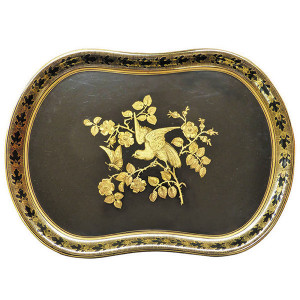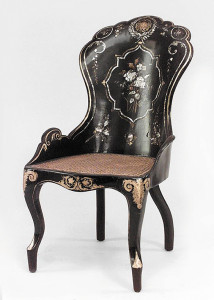Creating decorative and utilitarian objects basically made of paper and glue began in ancient Egypt. For centuries the process developed in India, China and the middle east, ever slightly changing. Though fragile in appearance much of 19th century examples are available and costly. A fine example of a decorative tray can cost as much as $8,000 in a retail setting. The more common styles are a couple of hundred dollars.
When it was re-discovered as a new type of decorative technique in 18th century France, it became known as papier maché.
By the 19th century papier maché began appearing in England as elaborate side chairs, lap desks, trays and inkstands. It even became a frame for wall clocks. As its popularity grew, by the mid-19th century it was made in America as larger pieces of furniture such as bed and sofa frames and small tables. The pieces were painted, trimmed with gilt and often mother-of-pearl. Subjects were floral, applied on a red or black ground. Some of the tables and fire screens had painted scenes.
 CLUES: The earliest English examples, still around can be recognized by their trim of powdered metals, such as gold leaf and gold powder. By 1824 inlays of mother-of-pearl and colored shells were used. From the 1830’s a variety of subjects were depicted with oil paints. The more unusual the piece, the more expensive it will be. Examples would be a rococo-style dressing table, desk or watch holder.
CLUES: The earliest English examples, still around can be recognized by their trim of powdered metals, such as gold leaf and gold powder. By 1824 inlays of mother-of-pearl and colored shells were used. From the 1830’s a variety of subjects were depicted with oil paints. The more unusual the piece, the more expensive it will be. Examples would be a rococo-style dressing table, desk or watch holder. Buyers should be wary of poorly repaired or restored pieces. Look for a smooth, satiny finish. If there are inlays they should be level with the surface. Condition and quality as well as design dictate price.
Early English Victorian pieces were done by specific artists. They can be recognized by the type of techniques and decorations they used. George Neville painted flowers on a black ground. David Sargent used bright greens with fern designs. Prices go up if a piece can be attributed to a particular artist.
Not all papier maché objects are worth the sometimes high, shop prices. By the end of the 19th century it had become over-embellished and downright ugly. Typical of the Victorian “over-kill” of everything. At that point its popularity died along with its manufacture.
In the late 1920s, 30s, a variety of small items, such as candy containers, were machine processed. The papier maché was pressed into bunny and Santa shapes.
The craft is still popular as a hobby and used in many different ways. Check the internet for details.
PHOTO CAPTIONS: (1) Finely done Victorian papier maché tray. PHOTO CREDIT: (1) 1ST DIBS
PHOTO CAPTION: (2) Victorian papier maché side chair PHOTO CREDIT(2) Newel, New York, NY
















Follow Us